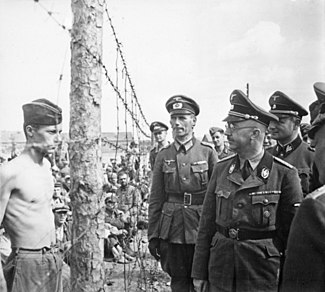Loading AI tools
European countries occupied by the military forces of Nazi Germany From Wikipedia, the free encyclopedia
German-occupied Europe (or Nazi-occupied Europe) refers to the sovereign countries of Europe which were wholly or partly militarily occupied and civil-occupied, including puppet governments, by the military forces and the government of Nazi Germany at various times between 1939 and 1945, during World War II, administered by the Nazi regime under the dictatorship of Adolf Hitler.[2]
German-occupied Europe | |||||||
|---|---|---|---|---|---|---|---|
| 1938–1945 | |||||||
| Anthem: 1938–1945 "Das Lied der Deutschen" "The song of the Germans" | |||||||
Europe at the height of German expansion in 1942:
| |||||||
| Capital | Berlin | ||||||
| Common languages | German | ||||||
| Demonym(s) | German | ||||||
| Reich Commissioner | |||||||
• 1938–1945 | Fritz Katzmann | ||||||
| Reichsstatthalter | |||||||
• 1938–1945 | Adolf Eichmann | ||||||
• 1940–1945 | Heinrich Himmler | ||||||
• 1941–1945 | Hermann Göring | ||||||
| Historical era | Interwar period | ||||||
| Area | |||||||
| 1942 | 3,300,000[1] km2 (1,300,000 sq mi) | ||||||
| Population | |||||||
• 1942 | 238,000,000[1] | ||||||
| Currency | Reichsmark (ℛℳ) | ||||||
| |||||||
The German Wehrmacht occupied European territory:
In 1941, around 280 million people in Europe, more than half the population, were governed by Germany or their allies and puppet states.[3] It comprised an area of 3,300,000 km2 (1,300,000 sq mi).[1]
Outside of Europe, German forces controlled areas of North Africa, including Egypt, Libya, and Tunisia between 1940 and 1945. German military scientists established the Schatzgraber Weather Station as far north as Alexandra Land in Francis Joseph Land. Manned German weather stations also operated in North America included three in Greenland, Holzauge, Bassgeiger, and Edelweiss. German Kriegsmarine ships also operated in all oceans of the world throughout World War II.
Several German-occupied countries initially entered World War II as Allies of the United Kingdom[4] or the Soviet Union.[5] Some were forced to surrender before the outbreak of the war such as Czechoslovakia;[6] others like Poland (invaded on 1 September 1939)[2] were conquered in battle and then occupied. In some cases, the legitimate governments went into exile, in other cases the governments-in-exile were formed by their citizens in other Allied countries.[7] Some countries occupied by Nazi Germany were officially neutral. Others were former members of the Axis powers that were subsequently occupied by German forces, such as Finland and Hungary.[8][9]
| Part of German-occupied Europe | |
|---|---|
 Head of the SS, Heinrich Himmler, inspects captured prisoners in German occupied Minsk, August 1941. | |
| Date | 1941–1945 |
Attack type | Starvation, death marches, executions, forced labor |
Germany operated thousands of concentration camps in German-occupied Europe. The first camps were established in March 1933 immediately after Adolf Hitler became Chancellor of Germany. Following the 1934 purge of the SA, the concentration camps were run exclusively by the SS via the Concentration Camps Inspectorate and later the SS Main Economic and Administrative Office. Initially, most prisoners were members of the Communist Party of Germany, but as time went on different groups were arrested, including "habitual criminals", "asocials", and Jews.
After the beginning of World War II, people from German-occupied Europe were imprisoned in the concentration camps. About 1.65 million people were registered prisoners in the camps, of whom about a million died during their imprisonment. Most of the fatalities occurred during the second half of World War II, including at least 4.7 million Soviet prisoners who were registered as of January 1945.
Following Allied military victories, the camps were gradually liberated in 1944 and 1945, although hundreds of thousands of prisoners died in the death marches.
After the expansion of Nazi Germany, people from countries occupied by the Wehrmacht were targeted and detained in concentration camps. In Western Europe, arrests focused on resistance fighters and saboteurs, but in Eastern Europe arrests included mass roundups aimed at the implementation of Nazi population policy and the forced recruitment of workers. This led to a predominance of Eastern Europeans, especially Poles, who made up the majority of the population of some camps. The ethnicities of captured people were various other groups from other different nationalities were transferred to Auschwitz or sent to local concentration camps.
The countries occupied included all, or most, of the following nations or territories:
| Government in exile | Capital in exile | Timeline of exile | Occupier(s) |
|---|---|---|---|
| September 16, 1944 – May 10, 1945 | |||
| 1944 – April 22, 1945 | |||
| March 28/29, 1945 – May 7, 1945 | |||
| 1944–1945 | |||
| Summer of 1944 – May 8, 1945 | |||
| April 4, 1945 – 8 May 1945 | |||
| October 7, 1944 – 8 May 1945 |
| Government in exile | Capital in exile | Timeline of exile | Occupier(s) |
|---|---|---|---|
(1923–1938)
|
1919 – present | ||
(1944 – August 20, 1991) |
June 17, 1940 – August 20, 1991 | ||
(1920–1939)
|
1920 – August 22, 1992 |
Seamless Wikipedia browsing. On steroids.
Every time you click a link to Wikipedia, Wiktionary or Wikiquote in your browser's search results, it will show the modern Wikiwand interface.
Wikiwand extension is a five stars, simple, with minimum permission required to keep your browsing private, safe and transparent.